|
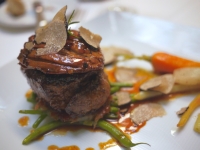 |
Tournedos Rossini
at Fouquet's in Paris. |
Tournedos Rossini are small beef steaks with foie gras and truffles. The dish is layered, starting with
crisp rounds of sautéed bread the same size as the beef tenderloin cuts, then foie gras, then truffles
and sauce. This is a fancy disk consisting of ingredients that are some of the most expensive and hard
to come on this planet.
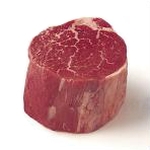
Filet mignon. |
Let's start with the meat. The tenderloin is the most tender cut of beef and is
also arguably the most desirable and therefore the most expensive. The meat is a filet mignon cut
from the smaller end of the tenderloin, or psoas major muscle of the cow. This is
the long muscle located on the side of the lumbar region of the vertebral column and brim of the lesser pelvis.
It is not a load-bearing muscle, therefore it is very tender, because it contains less connective tissue.
It is called filet de bœuf in French (filet mignon in French is reserved for pork),
and "fillet" in the UK.
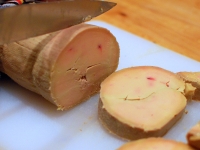
Foie gras. |
First, croutons are cut the same shape as the file slices. Next, the file slices are sautéed in butter
about 2 minutes per side and placed on top of the croutons. Next comes the foise gras, pâté made of
goose or duck liver. The tenderloin is a dry meat, so the foie gras is used to add some interest to the dish.
Foie gras is made from ducks or geese that have been purposely fattened by forcefeeding.
Forcefeeding is controversial because it is obviously very uncomfortable to the birds,
and a number of countries have laws against that. The technique of forcefeeding dates as far back as 2500 BC,
when the ancient Egyptians began keeping birds for food and deliberately fattened them through forcefeeding.
Most foie gras is produced by France, followed by Canada and China. On the other hand, the production of
foie gras is illegal in most of the rest of the EU, Norway, Argentina, and California.
For this dish, the foie gras is briefly pan-fried in butter at the last minute and placed on top of the steak.
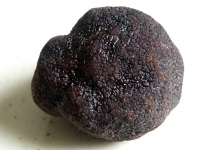
Truffe noire du Périgord. |
Next come the truffles. In general, truffles are the fruiting body of a subterranean Ascomycete fungus the genus
Tuber. French Black Trufffle is Tuber melanosporum. This is a species of truffle native to
Southern Europe and one of the most expensive edible mushrooms in the world.
The taste fully develops after they have been heated and is slightly peppery and bitter. They exude a scent
reminiscent of strawberries, wet earth or dried fruit with a hint of cocoa. They grow near trees,
at a depth of 5 cm (2.0 in) to 50 cm (20 in). For this dish, several pieces of shaved truffle are placed
on top of the foie gras.

Demi-glace sauce. |
Finally, the sauce. Demi-glace is a rich brown sauce originating in France. The name is derived from glace,
which means icing or glaze, when referring to a sauce, and demi meaning semi or half. Demi-glace sauce
consists of a mixture of half brown stock and half Espagnole Sauce, which has been reduced by half to produce a rich,
deeply flavorful sauce. Espagnole Sauce, in turn, is one of the five mother sauces
of classical French cuisine. It is made from brown veal stock, thickened with a brown roux.
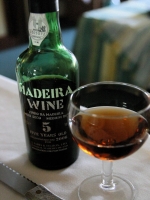
Madeira wine. |
Madeira wine is used in this recipe. It is a fortified Portuguese wine originating in the Madeira Islands oftshore Spain.
Madeira is produced in a variety of styles ranging from dry wines which can be consumed on their own as an aperitif,
to sweet wines more usually consumed with dessert.

Gioacchino Rossini. |
Tournedos Rossini are named after the Italian opera composer Gioacchino Antonio Rossini. He lived in Bologna, Florence
and Paris, wrote operas such as "The Barber of Seville", and loved good food. He took pride in saying that, by the age
of 30 of having known all the most famous chefs on the continent. He retired in 1829 at 37, after the successes
of his operas "The Barber of Seville" and "William Tell." He died 13 November 1868 at the age of 80 years old,
and was buried in Père Lachaise cemetery in Paris. At restaurants where he frequently ate in Paris, he would go
into the kitchen and greet the chef.
There are several lines of thought as to which restaurant and which chef created teh dish, but all agree
that it happened in Paris. It may have been Casimir Moisson at Maison Dorée, a famous restaurant located at
20 Boulevard des Italiens; Auguste Escoffier at the Savoy Hotel; possibly even Marie-Antoine Carême.
Making Tournedos Rossini is actually fairly quick and easy (it only takes about 30 minutes). It is the finding of
the proper ingredients and making the Demi-glace sauce that takes the time. To make proper veal stock takes
about 5-6 hours. To make the demi-glace sauce, it takes another hour to hour and a half (including making
the Espagnole sauce, which is a precursor leading to the Demi-glace sauce). Not a huge amount of it
is needed, so decide if you wish to outsource this, find a good deli, and buy it there.
Below is a nice recipe from the New York Times, keeping things true to the original recipe.
Ingredients:
- 2 filet mignons, about 5 ounces each
- Salt and black pepper
- 1/4 cup fond de veau (veal stock) - read our broth recipes
or use 1 tbsp veal demi-glace, which is available in fine food markets, mixed with 3 tbsp water
- 1 tbsp truffle juice
- 1 tsp black truffles, chopped
- 2 tbsp clarified butter
- 1 tbsp vegetable oil
- 2 slices French bread, trimmed to the shape of the filets mignons
- 2 slices fresh foie gras, about 2 ounces each
- 2 tbsp Madeira
- 2 thin slices black truffle
- YIELD: Serves 2
Preparation:
- Season the filets mignons with salt and pepper and set aside.
In a small bowl, combine the veal stock or demi-glace, truffle juice
and chopped truffles. Set aside.
- In a large skillet over medium heat, melt a third of the butter with the oil
and quickly fry the slices of bread until lightly browned on both sides. Remove
and set aside. Add another third of the butter to the skillet, and sauté the filet
mignons over high heat for 4 minutes a side for rare or 5 minutes a side for medium-rare.
Remove the filets from the skillet, set aside and keep warm.
- Using the same skillet and high heat, sauté the foie gras slices 90 seconds on each side
and place 1 slice on each of the filets.
- Discard all fat from the skillet. While the skillet is still hot, add the Madeira,
scraping the bottom of the pan. Add the veal stock mixture, bring to a quick boil,
then remove from heat and stir in the remaining butter to make a silky sauce.
Season with salt and pepper to taste.
- On each of two plates, place the croutons in the center, and top with the filet mignon
and foie gras. Garnish with a slice of truffle on the top.
Spoon the sauce over and around. Serve hot. Voilà!

Final touches for Tournedos Rossini. |
back to Radim and Lisa's Well-Travelled Cookbook | email us
Last updated: September 10, 2014

|








